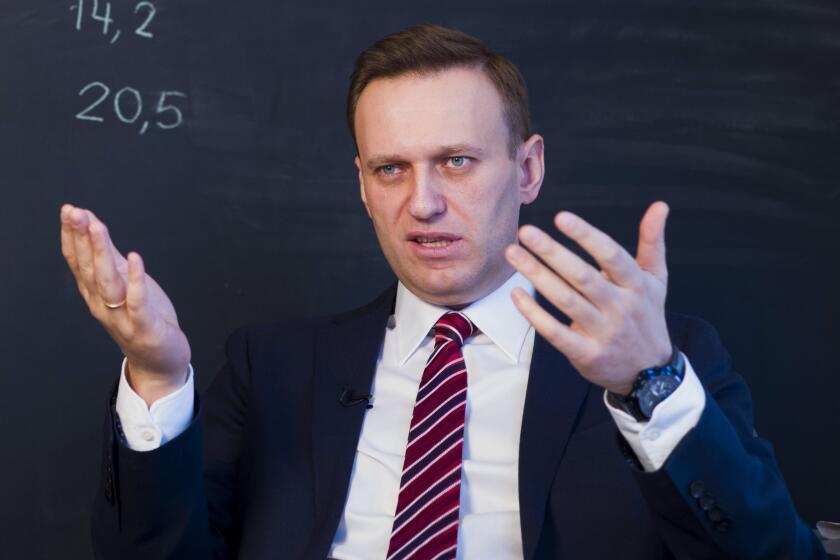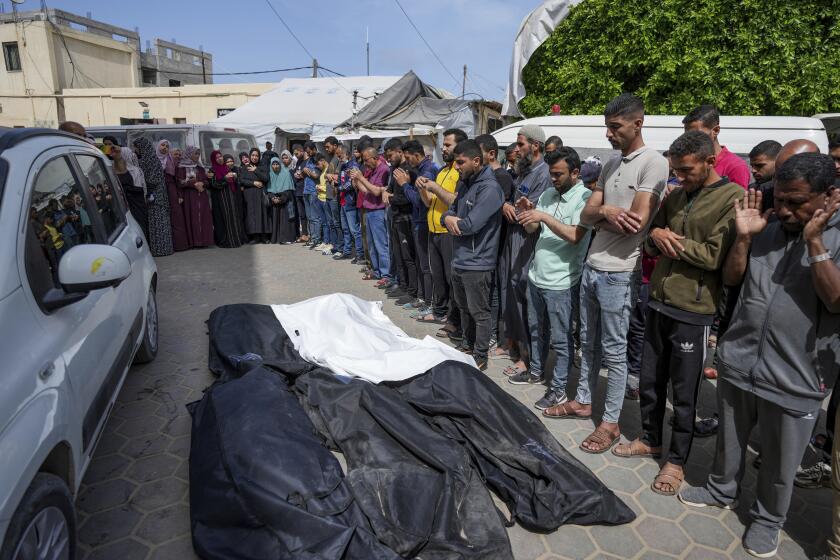Botched Iraqi Arms Deal Is Detailed
North Korean dictator Kim Jong Il bilked Saddam Hussein out of $10 million in an aborted deal to smuggle ballistic missile technology and other prohibited military equipment to Iraq shortly before the war, the chief U.S. weapons hunter said Friday.
The no-honor-among-tyrants case provides the first solid evidence that Iraq and North Korea were directly conducting clandestine business deals in violation of a United Nations arms embargo, senior Bush administration officials said.
The case is only one of several illegal Iraqi military procurement schemes uncovered by U.S. investigators since they began scouring Iraq early last summer for evidence of Hussein’s suspected weapons of mass destruction, according to David Kay, head of the weapons-hunting teams.
Other nations, including several in Europe, and companies and individuals are also under investigation, he said, but he declined to name them.
How significant such deals were is a matter of debate.
Kay, speaking to reporters in a conference call organized by the CIA, said he had uncovered a “rather remarkable amount” of evidence -- from smuggling schemes to hidden laboratories -- that Iraq had concealed from U.N. weapons inspectors. Had the U.N. Security Council known that last spring, he said, “I’m confident there would have been an uproar.”
But Hans Blix, the Swedish diplomat who led the prewar U.N. weapons inspections, said that Kay’s unclassified report showed only “some fairly minor items that should have been declared” to the U.N. and that they probably would not have affected council deliberations.
“It’s a long way from finding some minor things, as they did, to concluding Iraq was an imminent danger,” Blix said in a telephone interview from Stockholm.
Blix said most of Kay’s discoveries “don’t seem very big, and some may be legitimate dual-use items” that are allowed under U.N. rules because they have civilian applications.
“In many cases, Kay’s report says they may be suitable for this or suitable for that,” Blix said. “Well, a butcher’s knife is also suitable for murder.”
So far, Kay said, the group has found the greatest surprises in documenting Hussein’s covert efforts to develop and build medium- and long-range missiles able to fly well beyond the limit imposed by U.N. resolutions.
He said plans and advanced design work were found for three different rockets able to fly at least 625 miles and thus able to strike the capitals of Turkey or Egypt, or Dubai. Iraq also had launched a secret “crash program” to extend the range of old Soviet-era SAM-2 missiles and to convert Silkworm anti-ship cruise missiles into land-attack missiles.
The missile Iraq sought to buy from North Korea, called the Nodong-1, has a range of just over 800 miles.
Kay said his investigators discovered that Hussein’s regime negotiated and signed a contract with Pyongyang in late 1999 and paid $10 million in advance to secretly purchase Nodong missile technology, as well as other prohibited military equipment, in violation of U.N. sanctions.
Late last year, Kay said, the Iraqis demanded, “ ‘Where is the stuff we paid for?’ And the North Koreans said, ‘Sorry, there’s so much U.S. attention on us that we cannot deliver it.’ And the Iraqis said, ‘Well, we don’t like this but give us our $10 million back.’ ”
Kay said “lots of records” showed Iraqi officials frantically trying to recover the money and the North Koreans refusing or ignoring their pleas until U.S.-led forces invaded Iraq in March.
“It’s a lesson in negotiating with the North Koreans that the Iraqis found out the hard way,” Kay said.
In addition to the North Korean case, Kay’s investigators have reported finding scores of leads, suspects and clues related to Hussein’s covert weapons plans and programs, but none of the chemical, biological or nuclear arms that were one of the Bush administration’s chief justifications for going to war.
Speaking in Milwaukee, President Bush said the report supported many of his administration’s prewar claims about Hussein’s weapons programs.
“It states that Saddam Hussein’s regime had a clandestine network of biological laboratories,” Bush said. “They had a live strain of deadly agent called botulinum. And he had sophisticated concealment efforts. In other words, he’s hiding his program.”
A network of two dozen laboratories and safe houses was secretly set up and maintained by Iraqi intelligence services, Kay said in his conference call. He said investigators had visited the facilities, and equipment in them was “suitable” for chemical or biological weapons research and should have been declared to the U.N.
The Times disclosed the existence of the clandestine labs in June, citing a former Iraqi intelligence officer, and reported that they were part of a covert military research effort set up after 1996.
As for the botulinum, Kay said an Iraqi scientist, whom he did not identify, had stored a single vial of the live toxin, as well as a more virulent pathogen, in his home refrigerator in 1993. Kay said the scientist had small children and grew fearful “after a couple of days,” so he returned the more toxic vial to his boss.
But Kay said the stored sample of botulinum was still “viable” after a decade and thus could be used to create a biological warfare agent. His report notes that the scientist passed a polygraph test about Hussein’s plans to reconstitute a bioweapons programs and that he told investigators about “a large cache” of microbe agents. Teams are “actively searching for this second cache,” Kay reported.
Kay, who is special advisor to CIA Director George J. Tenet, testified on Capitol Hill for a second day Friday, briefing the Senate Armed Services Committee behind closed doors. On Thursday, he presented his highly classified interim report to the House and Senate intelligence committees.
A senior congressional aide who attended one of Kay’s closed briefings said the presentation was disappointing.
“At the end of the day it looks like the U.N. inspection process was more effective,” the aide said.
“The U.N. had better intelligence than the CIA.” In particular, the aide said, the U.N. inspectors and the International Atomic Energy Agency, the world body’s nuclear watchdog, appear to have produced more accurate assessments than the U.S. intelligence community about the status of Iraq’s chemical, biological and nuclear weapons programs.
“I think the U.N. and the IAEA were not victims of a mind-set with predetermined sort of views,” said the aide, who requested anonymity. “They were more empirical in their approach. I think they were less likely to draw sinister conclusions from ambivalent evidence or dual-use technologies.”
Kay declined to answer questions about the quality of prewar U.S. intelligence but said he was deliberately not using those reports as the “template” for his investigations in Iraq.
Kay said he and his top aides meet every Saturday afternoon to discuss why they have not found Hussein’s weapons. Among the “five or six working hypotheses,” he said, was that the weapons were moved out of Iraq before the war, that they were hidden immediately before or after the war “in ways that are inherently difficult for us to find,” and that the people who know their location “are still carrying out the resistance movement” against the postwar occupiers.
Another viable option, he said, was that the weapons program was an elaborate bluff -- and that perhaps even Hussein was deceived by scientists and aides too frightened to tell him the truth.
“We call it ‘Red on Red’ deception,” Kay said. “Saddam had become so isolated, so the argument goes, that in the last couple of years they consciously told him they were doing things that they in fact were not doing, just to continue to be rewarded by him.”
Times staff writers Greg Miller, Maura Reynolds and Edwin Chen contributed to this report.
More to Read
Start your day right
Sign up for Essential California for news, features and recommendations from the L.A. Times and beyond in your inbox six days a week.
You may occasionally receive promotional content from the Los Angeles Times.






